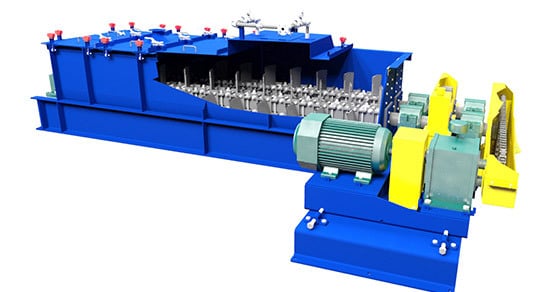Pugmill Mixers, also known as paddle mixers, are a type of continuous mixer used throughout many industries to carry out mixing, agglomerating, and conditioning of liquid and solid feed combinations. They have become indispensable in de-dusting fly ash, mixing copper concentrates for smelter production, and processing steel mill by-products.
Pugmill mixers have also become a critical asset in the fertilizer industry, where their diverse processing capabilities serve a number of purposes in the production of nutrient products.
How Pugmill Mixers are Used in Fertilizer Production
There are several ways in which a pugmill can be employed in fertilizer production processes:
Organics Granulation
The pugmill mixer often plays a key role in fertilizer production when working with organic materials such as digested dairy manure, biosolids, hog slurry, and other coarse or high-moisture solids.
In this setting, the device serves to mix material feedstock, along with any additives, into a homogeneous mixture, while also producing agglomerates. Raw feed materials are fed to the pugmill, thoroughly mixed and agglomerated, and discharged for drying and cooling. A screening and recycle circuit are utilized as well.
While this process relies on a high recycle rate, it yields a highly stable production environment.
Inorganic Fertilizer Production
Historically, the pugmill mixer, often referred to as a blunger in this setting, was more widely used in inorganic fertilizer production than it is today, but it can still offer a valuable option in some settings.
Pugmill granulation is a slurry ammoniation method that can be used to produce a number of different inorganic fertilizer products. Raw materials are pre-reacted in tanks and fed into the pugmill, where the intimate mixing action homogeneously mixes the feed components to complete the chemical reaction, producing a uniform, agglomerated product.
The remainder of the process follows the aforementioned process flow, with product going through drying, cooling, screening, and a recycle circuit. Here again, a high recycle rate is necessary.
Coating & Glazing
Pugmill mixers are also occasionally employed in granule finishing processes such as coating and glazing. Here, the mixing action, along with a spray system, evenly distributes the coating onto granules. This may be done for de-dusting, anti-caking, or other methods of improving a fertilizer product’s performance or handling qualities. In the production of potash, for example, granules are frequently wetted in a pugmill and then dried. This “glazing” process serves to eliminate sharp edges and fill in surface cracks, creating a recrystallized granule surface.
Benefits to the Pugmill Mixer in Fertilizer Production
The pugmill mixer is an incredibly diverse machine and offers a few key benefits in fertilizer production:
A Uniform Product
The pugmill is a highly capable device when liquid and solid feed components must be combined into a homogeneous mixture.
The dual-rotating shafts with pitched paddles impart a kneading and folding-over motion that intimately mixes materials, yielding a highly uniform product.
Simple Customization
The pugmill mixer also allows for easy inclusion of additives, making product customization a simple endeavor.
Pugmill Mixer Process Development
Testing in a facility such as the FEECO Innovation Center is an integral part of developing a successful pugmill operation for fertilizer production.
When working with a pugmill mixer, there are many process variables that can be adjusted and fine-tuned to produce a product of precise specifications. Testing determines the optimal combination of process parameters to produce the desired results on a continuous, commercial scale. Testing of additives or various binders is also typical.
Pugmill mixer testing in the FEECO Innovation Center
Testing is especially critical when working with organic-based materials, as they tend to vary significantly across sources. Additionally, it’s important to recognize that despite offering many benefits, the pugmill may not always be the best choice for the given material and process goals; testing may reveal that a pin mixer or granulation drum offers better performance or end product results for the given application.
Conclusion
Pugmill mixers serve as a diverse mixing and agglomerating device in the fertilizer industry. As pugmills are customizable and incredibly flexible, they should be designed around the process at hand to produce an optimal processing solution.
With an unmatched background in the fertilizer industry, FEECO is a leader in custom fertilizer production equipment and systems, including pugmill mixers, rotary dryers, coolers, and supporting material handling equipment. For more information on our pugmills, testing capabilities, or other fertilizer production equipment, contact us today!



